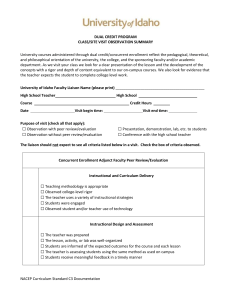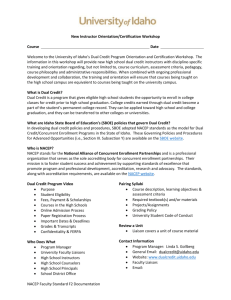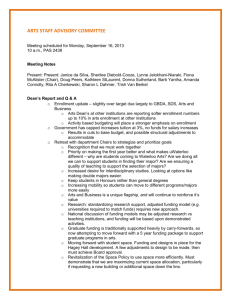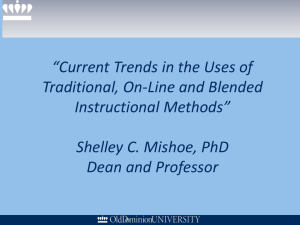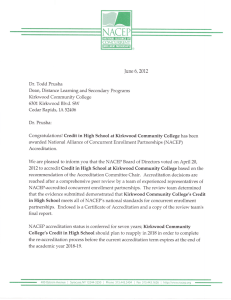NACEP Accreditation - The National Alliance of Concurrent
advertisement
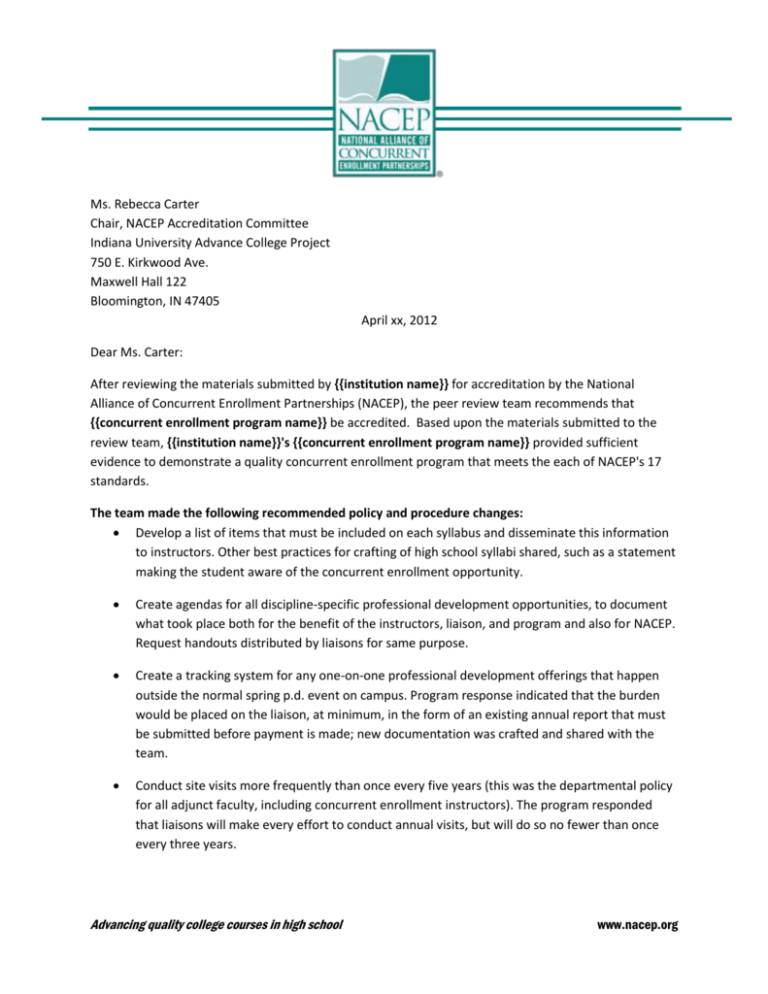
Ms. Rebecca Carter
Chair, NACEP Accreditation Committee
Indiana University Advance College Project
750 E. Kirkwood Ave.
Maxwell Hall 122
Bloomington, IN 47405
April xx, 2012
Dear Ms. Carter:
After reviewing the materials submitted by {{institution name}} for accreditation by the National
Alliance of Concurrent Enrollment Partnerships (NACEP), the peer review team recommends that
{{concurrent enrollment program name}} be accredited. Based upon the materials submitted to the
review team, {{institution name}}'s {{concurrent enrollment program name}} provided sufficient
evidence to demonstrate a quality concurrent enrollment program that meets the each of NACEP's 17
standards.
The team made the following recommended policy and procedure changes:
Develop a list of items that must be included on each syllabus and disseminate this information
to instructors. Other best practices for crafting of high school syllabi shared, such as a statement
making the student aware of the concurrent enrollment opportunity.
Create agendas for all discipline-specific professional development opportunities, to document
what took place both for the benefit of the instructors, liaison, and program and also for NACEP.
Request handouts distributed by liaisons for same purpose.
Create a tracking system for any one-on-one professional development offerings that happen
outside the normal spring p.d. event on campus. Program response indicated that the burden
would be placed on the liaison, at minimum, in the form of an existing annual report that must
be submitted before payment is made; new documentation was crafted and shared with the
team.
Conduct site visits more frequently than once every five years (this was the departmental policy
for all adjunct faculty, including concurrent enrollment instructors). The program responded
that liaisons will make every effort to conduct annual visits, but will do so no fewer than once
every three years.
Advancing quality college courses in high school
www.nacep.org
Page 2
Make the concurrent student guide available online, rather than solely in a printed version. This
has been done.
Revise the faculty site visit report to focus on content delivery rather than teaching ability. The
reviewers shared forms from their own programs as examples. With the assistance of their
advisory board, a new form will be crafted and implemented for fall 2011.
Send the post-graduate survey in December or during the spring semester, once students have
transferred credits. Their most recent survey was sent in August, before most students would
have started their freshman year of college. This change will be implemented December 2011.
The team found the following practices exemplary:
The concurrent enrollment program already had an Advisory Board, but as a consequence of the
accreditation process, it will now be convened regularly (twice each year) and additionally if
needed. One of the main roles the Board will serve is to review survey results (student,
instructor, principal, and counselor) and if needed, develop programmatic changes.
A literature faculty liaison recorded the entire high school class during her visit and then
provided a typed transcript in her report to the concurrent enrollment office. Not only does this
speak to the level of trust between the instructor and the liaison, it also indicates a high level of
engagement on the part of the liaison. Reading her observations in context of the transcript was
almost as good as having attended the class in person.
Each year, the concurrent enrollment instructors receive a folder with a list of items to collect
throughout the year. Sample student assignments, papers, assessment pieces, and the syllabus
are all kept in a central location and then submitted to the liaison for review at the spring
meeting.
Once a concurrent enrollment instructor has submitted grades, he/she receives a voucher for a
3 hour graduate course. If the instructor won’t use the voucher, it can be given away, or with
the principal’s permission, sold to another colleague for no more than $400. The classes are
funded by the College of Education.
The concurrent enrollment program has forged a partnership with their College of Education
(NCATE-accredited) for the coming year. Among other things, the College will assist the
concurrent enrollment office in the creation of a new program handbook, aligning 2011 NACEP
standards with concurrent enrollment documents and making changes as needed for
continuous program improvement.
Advancing quality college courses in high school
www.nacep.org
Page 3
The team identified and addressed the following areas of concern:
Site visits were being conducted once every five years (see fourth bullet under recommended
changes). Team’s recommendation to increase frequency was accepted and implemented.
The concurrent enrollment withdrawal policy seemed to imply students would be automatically
removed from the course, with no refund, if earning a poor grade, and this was not consistent
with the on-campus policy. Concurrent enrollment staff is revising the policy for consistency
with on-campus procedures.
Though not a factor shaping the outcome of the team’s recommendation, it should be noted that the
concurrent enrollment office was consistently cordial, open to implementing suggestions, and was early
or on time with all deadlines. They were a pleasure to work with throughout the process.
Respectfully Submitted,
Lead Reviewer
Reviewer 1
Reviewer 2
Advancing quality college courses in high school
www.nacep.org
